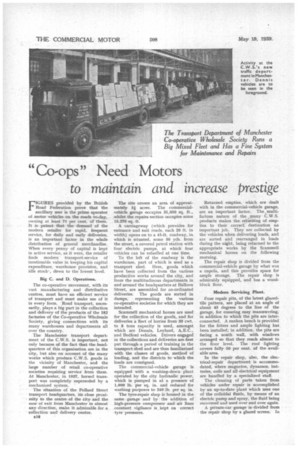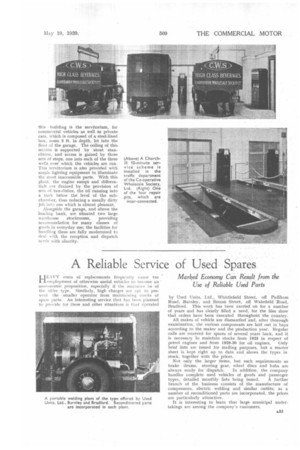"Co-ops" Need Motors to maintain and increase prestige
Page 50

Page 51

If you've noticed an error in this article please click here to report it so we can fix it.
The Transport Department of Manchester Co-operative Wholesale Society Runs a Big Mixed Fleet and Has a Fine System for Maintenance and Repairs
FIGURES provided by the British Road Federation prove that the ancillary user is the prime operator of motor vehicles on the roads to-day, owning at least 71 per cent. of them. It is patent that the demand of the modern retailer for rapid, frequent service, for daily and early deliveries, is an important factor in the whole distribution of general merchandise. When every penny of capital is kept in active service, as it were, the retailer finds modern transport-service of inestimable value in keeping his capital expenditure, warehouse provision, and idle stock-, down to the lowest level.
Big C and D. Operations.
The co-operative movement, with its vast mantrfacturing and distributive centres, must have an efficient service of transport and must make use of it in every form. Road transport, necessarily, plays a big part in the collection and delivery of the products of the /82 factories of the Co-operative Wholesale Society, giving connections with its many warehouses and departments all over the country.
The Manchester transport department of the C.W.S. is important, not only because of the fact that the headquarters of this organisation are in the city, but also on account of the many works which produce C.W.S. goods in the vicinity of Manchester, and the large number of retail co-operative societies requiring service from them. At Manchester, in 1937, horsed transport was completely superseded by a mechanized system.
The situation of the Pollard Street transport headquarters, its close proximity to the centre of the city and the ease of exit from Manchester in almost any direction, make it admirable for a collection and delivery centre. The site covers an area of approximately 54 acres. The commercialvehicle garage occupies 31,000 sq. ft.. Whilst the repairs section occupies some 15,270 sq. ft.
A carriageway (which provides for entrance and exit roads, each 20 ft. in width) opens on to a 45-ft. roadway, in which is situated, some 50 yds. from the street, a covered petrol station with four electric pumps, at which four vehicles can be refuelled at one time.
To the left of the roadway is the warehouse, part of which is used as a transport shed. Here, goods which have been collected from the various productive works around the city, and from the multitudinous departments in and around the headquarters at Balloon Street, are assembled for co-ordinated deliveries. The goods are sorted in dumps. representing the various co-operative societies for which they are intended.
Scammell mechanical horses are used for the collection of the goods, and for deliveries a fleet of lorries from 30 cwt. to 8 tons capacity is used, amongst which are Dennis, Leyland, A.E.C., and Bedford vehicles. Drivers engaged in the collections and deliveries are first put through a period of training in the transport shed and are thus familiarized with the classes of goods, method of loading, and the districts to which the loads are consigned.
The commercial-vehicle garage is equipped with a washing-down plant operated by the city hydraulic power, which is pumped in at a pressure of 1,000 lb. per sq. in. and reduced for washing purposes to 240 lb. per sq. in.
The tyre-repair shop is housed in the same garage and by the addition of high-pressure compressor and air lines constant vigilance is kept on correct tyre pressures. Returned empties, which are dealt with in the commercial-vehicle garage, are an important factor. The ,multifarious nature of the many C.W.S. products makes the returning of empties to their correct destination an important job. They are collected by the vehicles when delivering loads, and are sorted and rearranged in loads during the night, being returned to the appropriate works by the Scammeli mechanical horses on the following morning.
The repair shop is divided from the commercial-vehicle garage by what was a cupola, and this provides space for ample storage. The repair shop is admirably equipped, and has a woodblock floor.
Modern Servicing Plant.
Four repair pits, of the latest glazedtile pattern, are placed at an angle of about 45 degrees to the line of the garage, for ensuring easy manceuvring, in addition to which the pits are interconnected. A sunken bench is provided for the fitters and ample lighting has been installed; in addition, the pits are facing a south wall, with windows arranged so that they reach almost to the floor level. The roof lighting covers fully 50 per cent, of the available area.
In the repair shop, also, the electrical-repair department is accommodated, where magnetos, dynamos, batteries, coils and all electrical equipment are handled by a specialized staff.
The cleaning of parts taken from vehicles under repair is accomplished by an up-to-date plant which uses one of the colloidal fluids, by means of an electric pump and spray, the fluid being recovered and used over and over again.
A private-car garage is divided from the repair shop by a glazed screen. In this building is the servitorium, for commercial vehicles as well as private cars, which is composed of a steel-lined box, some 5 ft. in depth. let into the floor of the garage. The ceiling of this section is supported by stout stanchions, and access is gained by three sets of steps, one into each of the three wells over which the vehicles are run. This servitorium is also provided with ample lighting equipment to illuminate the most inaccessible parts. With this plant, the engine sumps and differentials are drained by the provision of sets of tun-dishes, the oil running into a tank below the level of the subchamber, thus reducing a usually dirty job into one which is almost pleasant.
Alongside the garage, and above the loading bank, are situated two large warehouse stockrooms, providing accommodation for many classes of goods in everyday use; the facilities for handling these are fully modernized to deal with the reception and dispatch needs with alacrity.




















































































